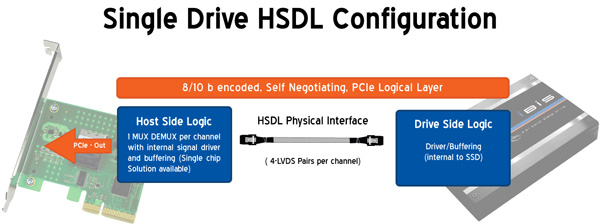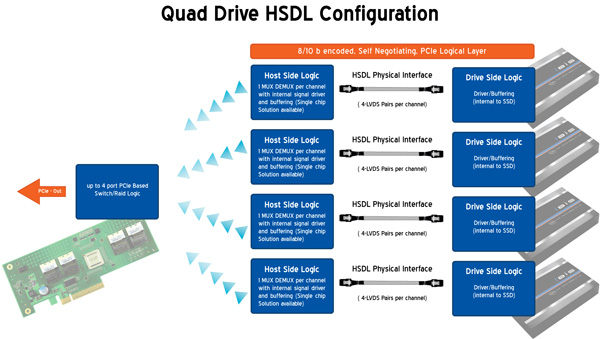OCZ's Fastest SSD, The IBIS and HSDL Interface Reviewed
by Anand Lal Shimpi on September 29, 2010 12:01 AM ESTTake virtually any modern day SSD and measure how long it takes to launch a single application. You’ll usually notice a big advantage over a hard drive, but you’ll rarely find a difference between two different SSDs. Present day desktop usage models aren’t able to stress the performance high end SSDs are able to deliver. What differentiates one drive from another is really performance in heavy multitasking scenarios or short bursts of heavy IO. Eventually this will change as the SSD install base increases and developers can use the additional IO performance to enable new applications.
In the enterprise market however, the workload is already there. The faster the SSD, the more users you can throw at a single server or SAN. There are effectively no limits to the IO performance needed in the high end workstation and server markets.
These markets are used to throwing tens if not hundreds of physical disks at a problem. Even our upcoming server upgrade uses no less than fifty two SSDs across our entire network, and we’re small beans in the grand scheme of things.
The appetite for performance is so great that many enterprise customers are finding the limits of SATA unacceptable. While we’re transitioning to 6Gbps SATA/SAS, for many enterprise workloads that’s not enough. Answering the call many manufacturers have designed PCIe based SSDs that do away with SATA as a final drive interface. The designs can be as simple as a bunch of SATA based devices paired with a PCIe RAID controller on a single card, to native PCIe controllers.

The OCZ RevoDrive, two SF-1200 controllers in RAID on a PCIe card
OCZ has been toying in this market for a while. The zDrive took four Indilinx controllers and put them behind a RAID controller on a PCIe card. The more recent RevoDrive took two SandForce controllers and did the same. The RevoDrive 2 doubles the controller count to four.
Earlier this year OCZ announced its intention to bring a new high speed SSD interface to the market. Frustrated with the slow progress of SATA interface speeds, OCZ wanted to introduce an interface that would allow greater performance scaling today. Dubbed the High Speed Data Link (HSDL), OCZ’s new interface delivers 2 - 4GB/s (that’s right, gigabytes) of aggregate bandwidth to a single SSD. It’s an absolutely absurd amount of bandwidth, definitely more than a single controller can feed today - which is why the first SSD to support it will be a multi-controller device with internal RAID.
Instead of relying on a SATA controller on your motherboard, HSDL SSDs feature a 4-lane PCIe SATA controller on the drive itself. HSDL is essentially a PCIe cable standard that uses a standard SAS cable to carry a 4 PCIe lanes between a SSD and your motherboard. On the system side you’ll just need a dumb card with some amount of logic to grab the cable and fan the signals out to a PCIe slot.
The first SSD to use HSDL is the OCZ IBIS. As the spiritual successor to the Colossus, the IBIS incorporates four SandForce SF-1200 controllers in a single 3.5” chassis. The four controllers sit behind an internal Silicon Image 3124 RAID controller. This is the same controller used in the RevoDrive which is natively a PCI-X controller, picked to save cost. The 1GB/s of bandwidth you get from the PCI-X controller is routed to a Pericom PCIe x4 switch. The four PCIe lanes stemming from the switch are sent over the HSDL cable to the receiving card on the motherboard. The signal is then grabbed by a chip on the card and passed through to the PCIe bus. Minus the cable, this is basically a RevoDrive inside an aluminum housing. It's a not-very-elegant solution that works, but the real appeal would be controller manufacturers and vendors designing native PCIe-to-HSDL controllers.
OCZ is also bringing to market a 4-port HSDL card with a RAID controller on board ($69 MSRP). You’ll be able to raid four IBIS drives together on a PCIe x16 card for an absolutely ridiculous amount of bandwidth. The attainable bandwidth ultimately boils down to the controller and design used on the 4-port card however. I'm still trying to get my hands on one to find out for myself.













74 Comments
View All Comments
punjabiplaya - Wednesday, September 29, 2010 - link
If I understood this correctly, OCZ is just using PCIe signaling over a SAS cable (with accompanying card to demux and pass on to the PCIe lanes)? That's ingenious.davecason - Wednesday, September 29, 2010 - link
This method also makes it easy to port it to a laptop interface through an express card socket.vol7ron - Wednesday, September 29, 2010 - link
Isn't that what PCIe RAID controllers do (minus the SAS cable)?TinyTeeth - Saturday, October 2, 2010 - link
I'm pretty sure they communicate with regular SATA SSD drives through the SATA interface, whereas HSDL brings PCIe all the way to the SSD drive. This would be why IBIS supports much higher IOPS than previous PCIe SSD solutions like the Z-Drive (which were limited by SATA RAID). Someone please correct me if I'm wrong about this.Ethaniel - Wednesday, September 29, 2010 - link
675 MB/s in sequential write? I just feel sad all of a sudden. SSDs are so forbidden for me right now, but this is a true monster. Maybe they'll make a more "down-to-Earth" version next time. Good stuff, anyway.vol7ron - Wednesday, September 29, 2010 - link
If only I could burn DVDs that fast.Lerianis - Saturday, October 2, 2010 - link
You still burn DVD's? Hell, I stopped doing that a few months ago when I realized that 99% of the stuff I burned was really a 'watch-once and never again' thing and went out to get one of those 2.5" 1TB external hard drives.Haven't burned another DVD since.
rqle - Wednesday, September 29, 2010 - link
too much proprietary peripherals, if i am going to use a PCIe card, I might as well just stick with a revodrive. pcie slots, proprietary slots connectors, proprietary cable, proprietary disk drive interface, blah. ill just stick with their own revodrive for now and wait for sata or sas controllers to pick up speed.jo-82 - Wednesday, September 29, 2010 - link
SAS cabels aren't that expensive these days, and the most companies who would by one of these use them today anyway.And good luck waiting the next 3-5 years or so for SATA 12GB ;)
vol7ron - Wednesday, September 29, 2010 - link
Gb, not GB